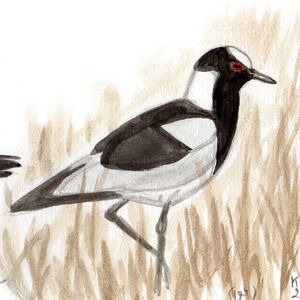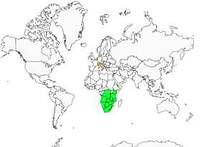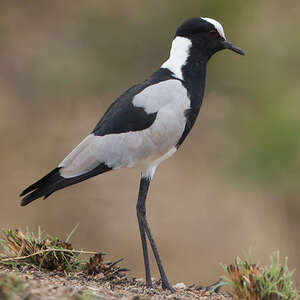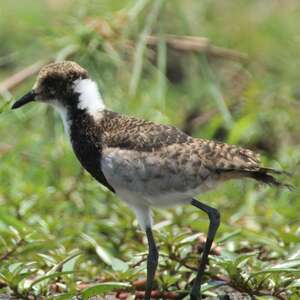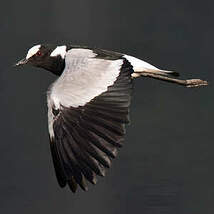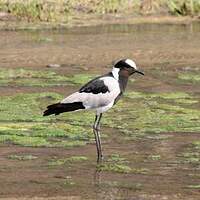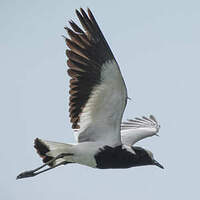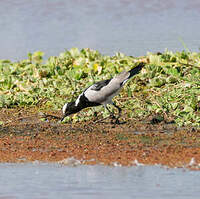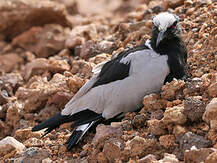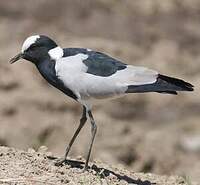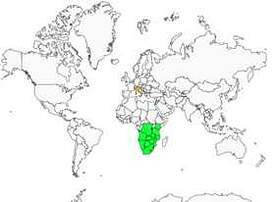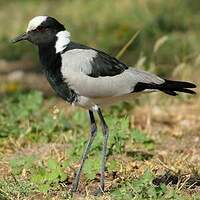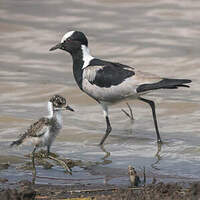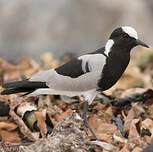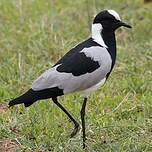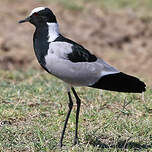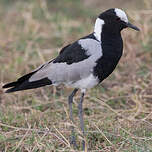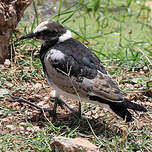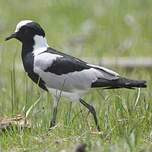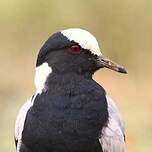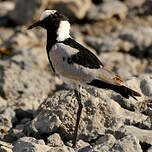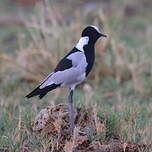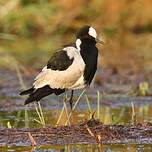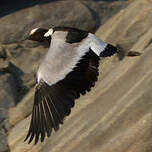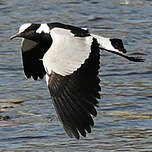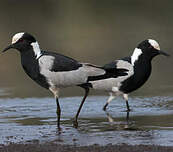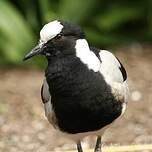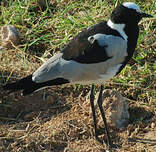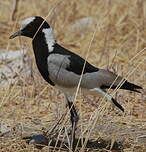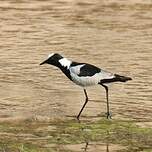Blacksmith Lapwing
Vanellus armatus - Vanneau armé
Identification
The Blacksmith Lapwing is a medium-sized lapwing (about 30 cm in length, weighing 200 g), elegant, with long legs and a thin bill. It is easily recognized by its unique plumage among lapwings.
From afar, the adult appears black and white with a unique combination of these colors. Up close one sees that what was thought to be white is actually white and very pale gray. The head is black with a wide white forehead patch which touches the dark red eye. The neck is black in front and white from the nape. This is enough for identification. The body is bi-colored, black in front (cloak, back and chest) and white in the back (belly, upper and lower tail coverts). In flight, wings and tail appear bi-colored: gray coverts above and white below and black remiges; white tail ended with black. The spur which the bird wears on the wrist of the wing and which gave it its name is especially visible in flight. Legs and bill are black.
The juvenile has the top of the head and all the upper parts (body and wing coverts), with the tectrices bordered by light beige, giving the bird a characteristic spotted look that allows it to better camouflage on the ground. Its belonging to the species is attested by its black and white neck like the adult, with the exception of the white throat whose white descends on the neck.
Subspecific information monotypic species
Foreign names
- Vanneau armé,
- Avefría armada,
- abibe-preto-e-branco,
- Schmiedekiebitz,
- patkós bíbic,
- Smidsplevier,
- Pavoncella fabbro,
- smedvipa,
- Smedvipe,
- cíbik čiernochrbtý,
- čejka běločelá,
- Broget Vibe,
- seppähyyppä,
- Bontkiewiet,
- fredeluga armada,
- czajka srokata,
- Пигалица-кузнец,
- シロクロゲリ,
- 黑背麦鸡,
- smedvipa,
- 黑枕麥雞,
Voice song and call
Habitat
Behaviour character trait
The Blacksmith Lapwing usually lives in pairs. Outside the breeding season, it can be found in small groups. It is a very territorial bird, particularly when it has a nest. It doesn't hesitate to attack bigger intruders, such as the Nile monitors, by diving on them and producing loud cries. It is essentially sedentary and only local movements have been observed according to the rain regime.
Dietfeeding habits
Reproduction nesting
The Blacksmith Lapwing is monogamous. It can breed all year round depending on the latitude. For example in South Africa, most of its breeding occurs during the dry season from August to October.
In Zambia, it has been noticed in April. Generally, there is only one brood per year, sometimes two, especially when the first one has been lost. The nest, rudimentary, is a small depression on the ground, rarely away from water, lined with a few twigs. The female lays 3 or 4 eggs, whose color varies from beige to brown, sometimes green-bronze. They are incubated by both parents for a period of 24 to 28 days. The chicks stay with the parents for about forty days before they become independent. Although the adults fiercely defend their nest, about half of the chicks don't survive, due to predation from raptors, monitors, jackals, or ravens.Geographic range
From East Africa (Kenya, Tanzania) to South Africa. The Blacksmith Lapwing (Vanneau armé) is seen in all these regions.
Threats - protection
Sources of information
- IOC World Bird List (v15.1), Gill, F and D Donsker (Eds). 2025-12-07.
- Roberts Bird Guide, Hugh Chittenden
- Hanbook of the birds of the world - Vol 15, del Hoyo J., Elliott A. Christie D.
- Birds of Africa South of the Sahara, Ian Sinclair and Peter Ryan
- Birds of the World, The Cornell Lab of Ornithology
Other sources of interest
 Specification sheet created on
30/07/2023 by Dietmar Petrausch
Specification sheet created on
30/07/2023 by Dietmar PetrauschTranslation by AI Oiseaux.net
© 1996-2025 Oiseaux.net
- Accipitriformes
- Aegotheliformes
- Anseriformes
- Apodiformes
- Apterygiformes
- Bucerotiformes
- Caprimulgiformes
- Cariamiformes
- Casuariiformes
- Charadriiformes
- Ciconiiformes
- Coliiformes
- Columbiformes
- Coraciiformes
- Cuculiformes
- Eurypygiformes
- Falconiformes
- Galliformes
- Gaviiformes
- Gruiformes
- Leptosomiformes
- Mesitornithiformes
- Musophagiformes
- Nyctibiiformes
- Opisthocomiformes
- Otidiformes
- Passeriformes
- Pelecaniformes
- Phaethontiformes
- Phoenicopteriformes
- Piciformes
- Podargiformes
- Podicipediformes
- Procellariiformes
- Psittaciformes
- Pterocliformes
- Rheiformes
- Sphenisciformes
- Steatornithiformes
- Strigiformes
- Struthioniformes
- Suliformes
- Tinamiformes
- Trogoniformes

